Roadmaps are a unique tool for creating and maintaining stakeholder alignment, resource planning, and budgeting purposes. But what happens when you’re managing a product that is being continually updated?
This is the situation for countless SaaS product management professionals lucky enough to manage products via this model. When the only things standing between you and your customers seeing an update is deciding to push code to production, things can get fast and furious in a hurry.
Roadmaps can help reign in the chaos that might erupt when there are fewer barriers between coders and consumers. They can get everyone on the same page, carve out some boundaries, and focus on the big picture versus the daily grind.
Of course, not every roadmap is well suited for a SaaS operation, so we’ve selected five very different types of roadmap templates that can play a critical role in keeping a SaaS product’s house in order despite the non-stop pace of product development.
5 Roadmap Templates for SaaS Businesses
1. Product roadmap
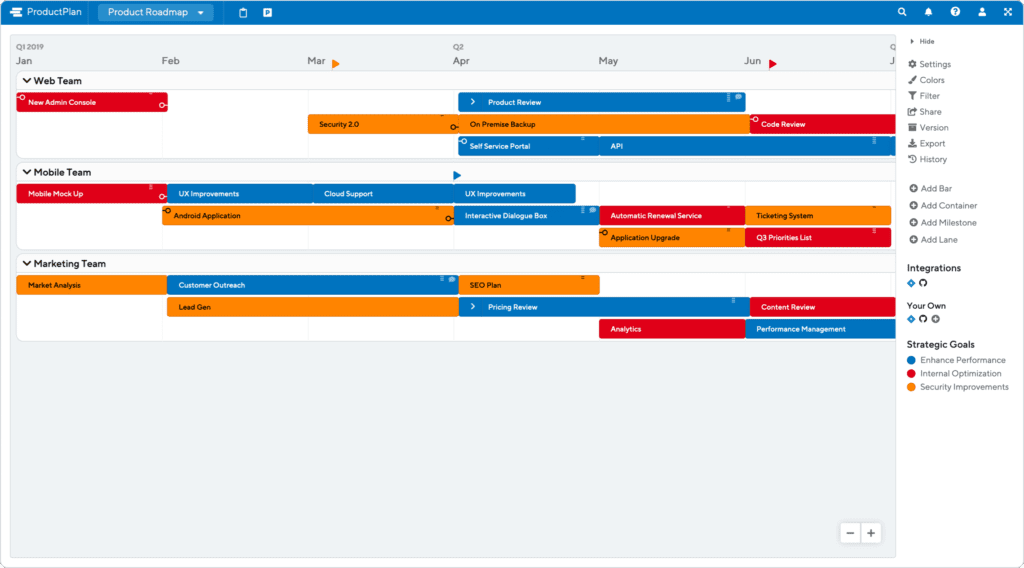
The product roadmap is (or should be) the foundation upon which all other plans are laid. It is where the product vision is translated into a plan for execution. And it’s the ideal tool for getting the entire organization to understand and buy into the strategy the team has selected to make that vision a reality.
Traditional product roadmaps document the sequential order of features and enhancements and when they’re scheduled for delivery. Think “Single-Sign-On” in February or “Drag-and-Drop Editor” in Q2.
This approach emphasizes specific features and dates, which can obscure the product strategy’s big picture goals. It also highlights individual items and particular dates, which many stakeholders (particularly salespeople and customers) can get very attached to. This limits the ability to adjust things over time as expectations have already been laid.
Basing a product roadmap on themes is an alternative to this model that allows for more flexibility during the implementation phase while reframing the conversation around strategy and outcomes versus a specific functionality checklist. Laying out a plan to “Improve Onboarding” before “Streamlining Checkout” shifts the spotlight to the significant picture objectives for the product, which is what matters, while avoiding the trap of committing to deliverables that may no longer make sense in a few months or years.
Without a reliable product roadmap, every other well-intended plan (or roadmap) is likely based on faulty assumptions or bad intelligence. So don’t pass Go, and don’t collect $200 until you’ve got your product roadmap locked down.
2. Product development roadmap
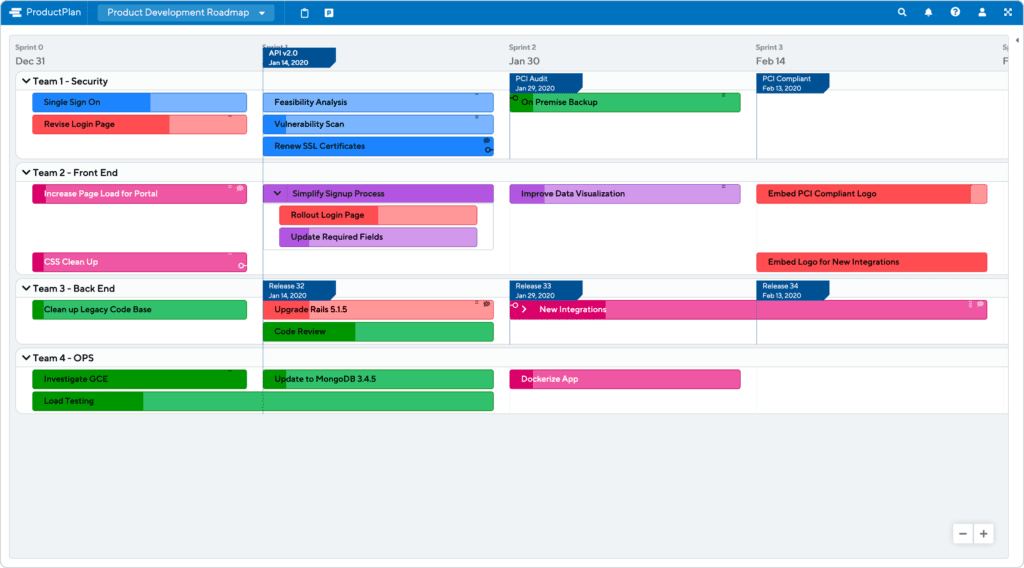
If there’s one roadmap SaaS businesses should use that is chock full of details and specifics, it’s a product development roadmap. Here is where each sprint’s target items are laid out, using swimlanes to denote which teams are working on what.
Because this roadmap is so detailed, it also has the shortest time horizon of them all, typically only spanning a couple of months. That’s because forecasting anything beyond that with this level of detail is a fool’s errand given the dynamic nature of the business and the emphasis on reacting to the latest data and opportunities.
The audience for this roadmap is primarily the teams responsible for delivering the projects it contains. It should definitely be limited on a need-to-know basis versus widely circulated since most stakeholders outside this part of the organization really don’t need this granular view into what’s being worked on when.
The purpose of this roadmap is to ensure timely execution and synergy across the teams working on getting these projects shipped. It’s not intended to convey strategy or business objectives, just how things are going to happen once those are locked in for the coming sprints.
3. UX/UI roadmap
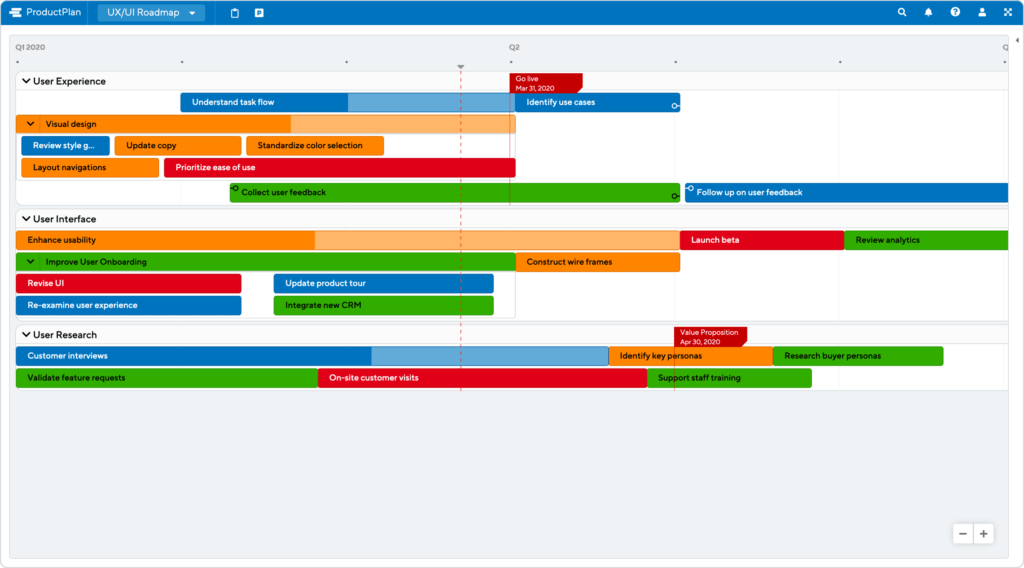
The user experience and user interface aspects of products don’t always get the respect and attention they deserve, but these activities actually start well in advance of product development and extend far beyond the release of the product. To fully grasp the scope of what’s included on a UX/UI roadmap, you must consider the three types of activities these teams are responsible for.
First, there’s user research, which is essential in understanding users, their challenges, and their desires. Without this information, any product roadmap is missing an essential ingredient, and these activities extend from the planning phases to prototype/alpha/beta testing and then evaluating how users are interacting with the “finished” product before repeating the cycle all over again.
Next comes the user experience perspective, which must account for how the product fits into the overall user workflow, which tasks they must complete, and how they might accomplish that. And finally, there’s the user interface, where the details of buttons, menus, page design and the like come into play, which will inform the product development team’s activities.
Calling out these chunks of work and phases of the project in a roadmap is beneficial in a few key ways. It identifies dependencies for downstream activities so things can be scheduled appropriately, plus it can be a huge help with resourcing, particularly when UX/UI staff work on multiple products. The roadmap also highlights just how important this work is and the breadth of its scope, since too often UX/UI is often misperceived as just “graphic design” work.
UX/UI roadmaps don’t need to extend as far as some of the other types, since their priorities and schedules are driven by what’s being prioritized and slotted by the product teams and when product development needs things to move forward. A six-month view is usually sufficient.
4. Quarterly release plan
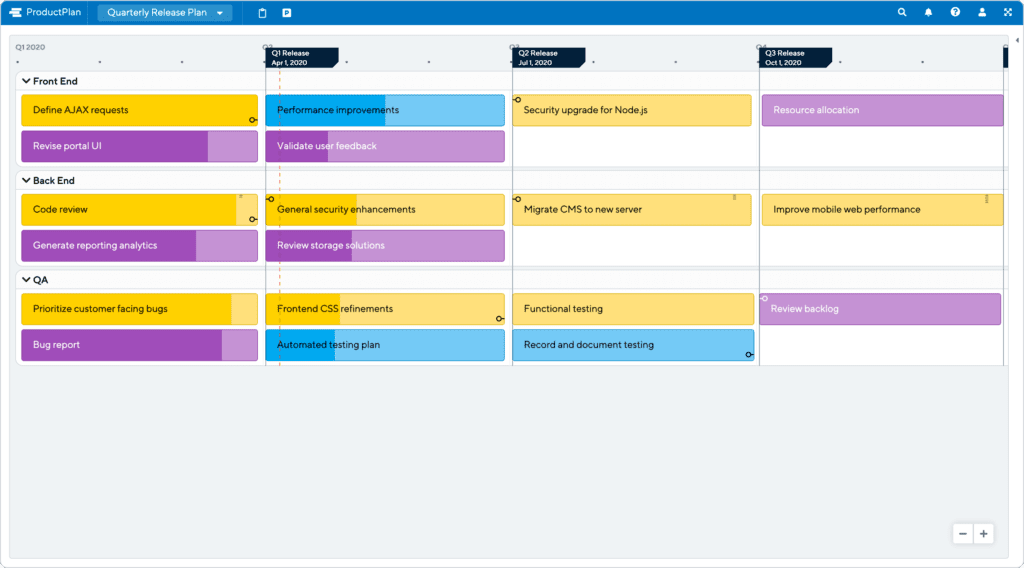
In a perfect world, the product organization, product development, and the UX team would be left to their own devices and trusted to deliver the highest-value projects in a timely fashion. But since this is reality, people still want to know when things are going to happen.
Providing some visibility and clarity around dates while still not pinning anyone down to an exact date is a bit of a tightrope act, but a quarterly release plan is often enough to satisfy the curious, impatient masses without boxing the team into a corner by committing to anything too specific. It’s the perfect complement to a theme-based product roadmap.
The estimated times of arrival for key features, functionality, and initiatives are quite helpful for many parts of the organization, particularly the sales and marketing wing of the operation. With a ballpark of idea of when things are coming to market, the marketing team will know when they should start thinking about budget, positioning, and launch events, not to mention training up the sales team on value propositions and talking points.
Limiting commitments to quarters and still not listing out the exact features but rather general themes allows the product team to maintain flexibility. They can pivot based on the health of KPIs based on popular SaaS product metrics such as Monthly Recurring Revenue, churn, and Net Promoter Score while still offering up a relatively accurate preview of what’s to come.
5. Marketing strategy roadmap
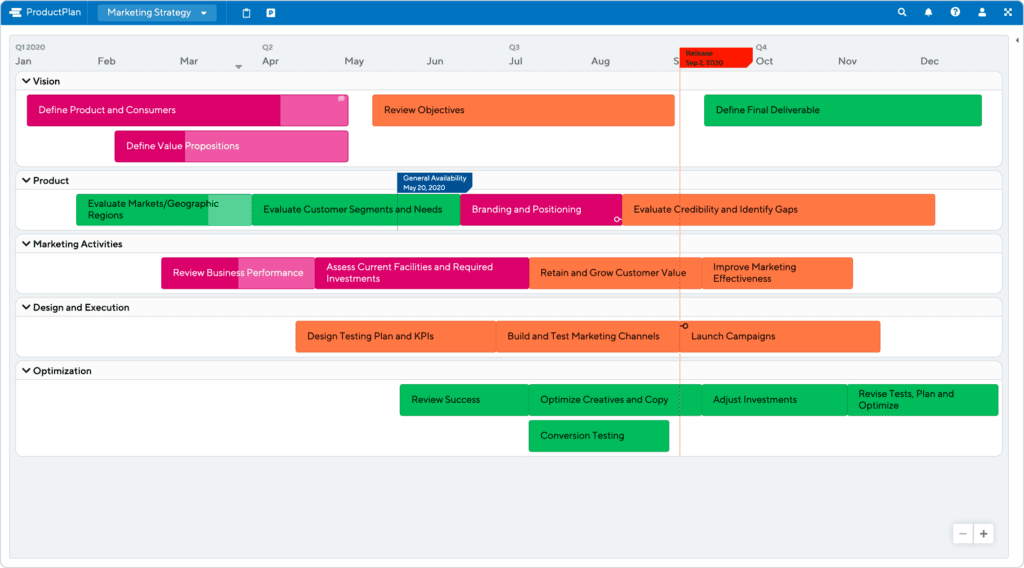
The greatest product in the world isn’t going to make any noise if it doesn’t have a solid plan in place to take it to market and drum up interest. That’s why no product strategy is complete without including an accompanying marketing strategy.
With so many channels and opportunities to promote a product’s benefits and capabilities, marketing teams need a detailed plan of their own to execute a winning debut and a continued long tail of attention-grabbing, lead-generating tactics. To keep everything straight and synchronized, a marketing strategy roadmap puts it all in one concise view that can ensure flawless execution and keep other stakeholders informed.
Marketing strategy roadmaps also come in handy when plans for the product itself change. The knock-on effect of a delay or shifting priorities will inevitably impact the communication plan and messaging, so this visual tool can quickly identify what must adjust downstream in the marketing department.
Takeaways: Sharing and caring
No matter which roadmap template you use, how and when you share your roadmap is just as important as its contents. It’s also vital to remember that every roadmap isn’t well-suited for everyone, and they should be shared selectively and intentionally for maximum impact.
And, obviously, roadmaps are only helpful when their accurate, so product teams must make it a habit to update them all regularly to avoid teams and stakeholders operating using outdated information. Using a purpose-built roadmapping tool makes this much easier and ensures every roadmap is a real-time view of the latest and greatest information.




